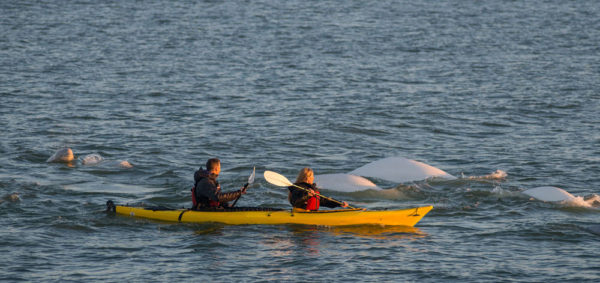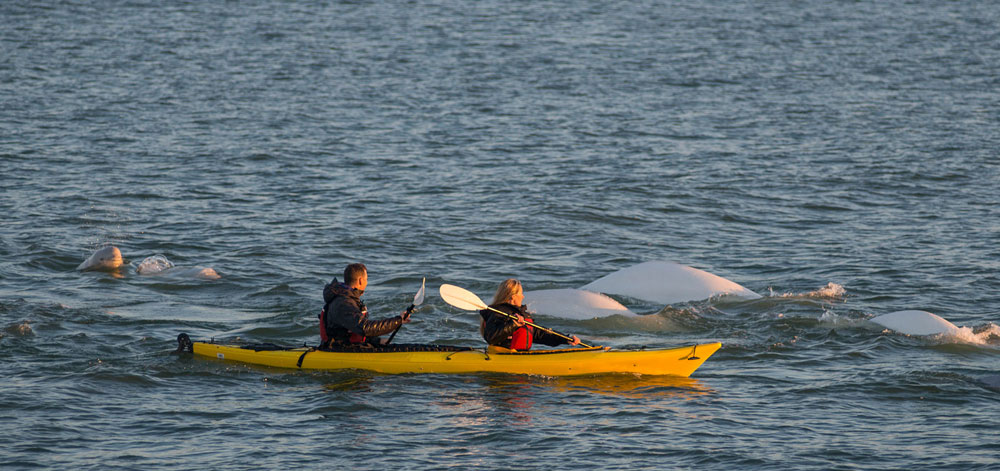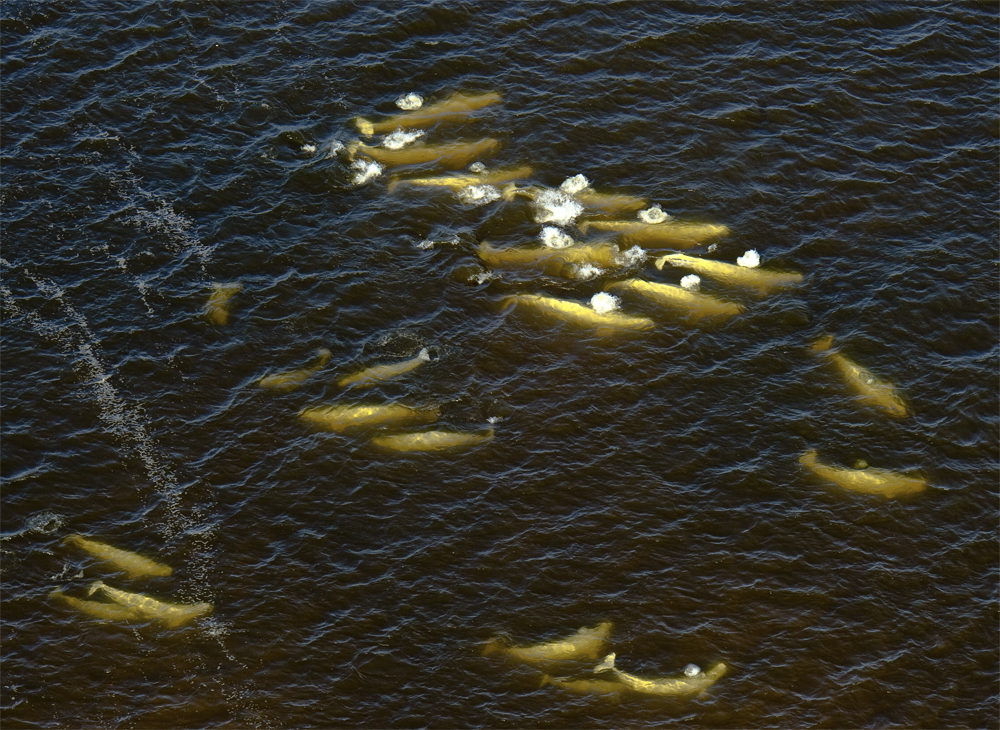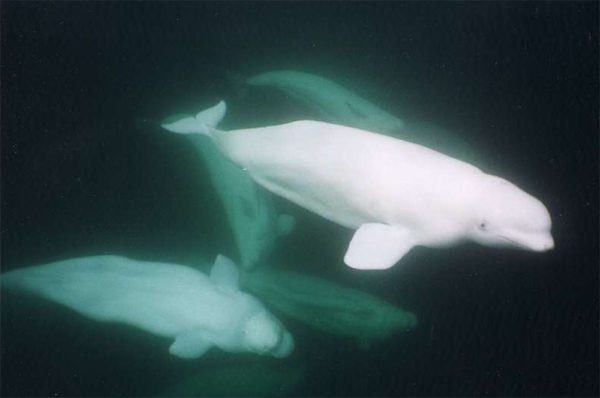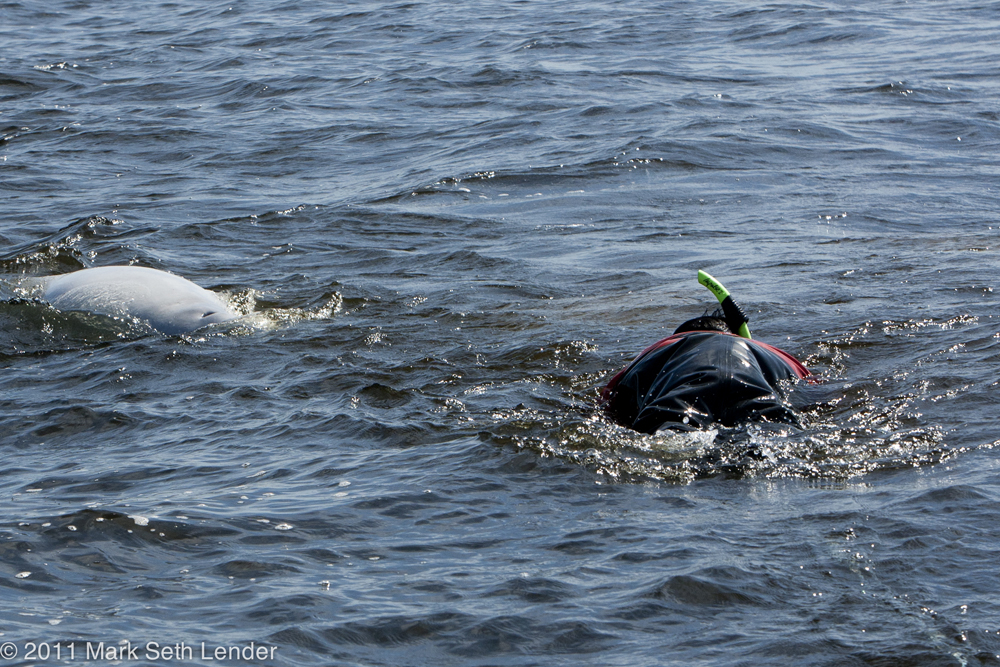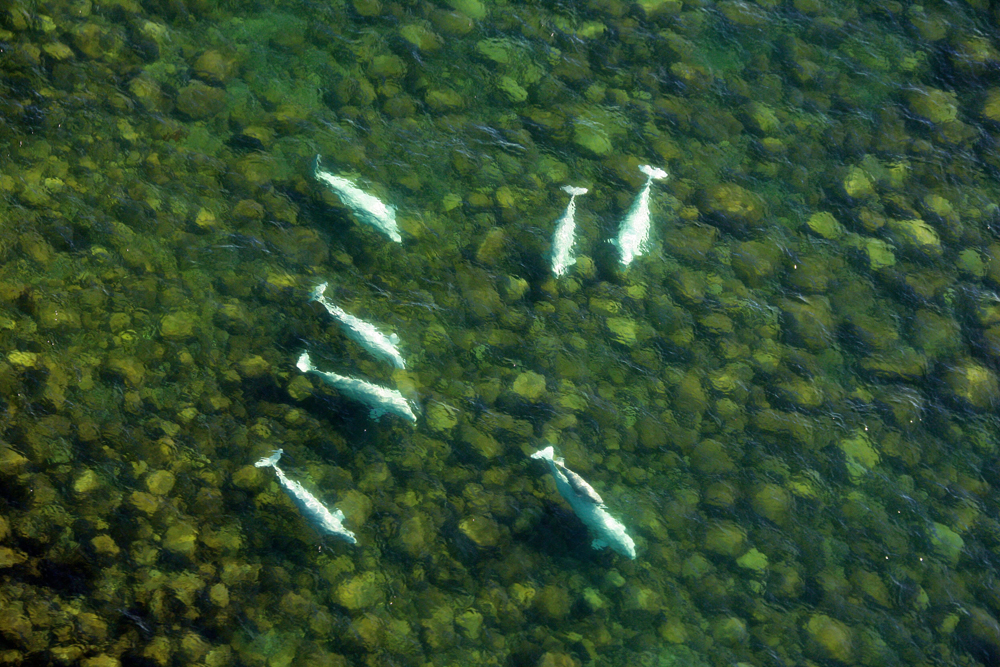Conservation and sustainability projects are often initiated only after a habitat or species has shown signs of deterioration, which is sometimes too late. Manitoba’s recently released Beluga Habitat Sustainability Plan (PDF) is ahead of its time.
“The idea is to get out in front of something,” said Kristin Westdal of the Pew Charitable Trusts’ Oceans North Canada. “So that a thousand years down the road we keep it intact for both animals and people. It’s about the protection of water, the land, the marine life and a culturally significant resource. Inuit use this area and want it to stay as is.”
The Manitoba Beluga Habitat Sustainability Plan was developed for the west coast of Hudson Bay, including the Seal, Churchill and Nelson River estuaries, which are home to the largest summering population of beluga whales in the world.
The goals as listed in Manitoba’s Beluga Habitat Sustainability Plan are to:
- Identify and protect vital beluga habitat
- Develop and enhance our understanding of beluga habitat requirements and uses
- Identify future research and partnership opportunities to fill knowledge gaps
- Identify and encourage public education opportunities to foster a stronger understanding and appreciation of belugas in Manitoba
Contributors to the Beluga Habitat Sustainability Plan include Oceans North Canada, the Town of Churchill, the Churchill Chamber of Commerce, the Canadian Parks and Wilderness Society, Manitoba Hydro, Manitoba Infrastructure and Transportation, Travel Manitoba, tourism operators and individuals with decades of experience working with belugas.
The varying perspectives and extensive knowledge gained from this unique collaboration of stakeholders have been distilled into a comprehensive approach to conserving and protecting the beluga habitat on Canada’s Hudson Bay coast, as well as the watersheds that nourish an area that includes the Seal, Churchill and Nelson River estuaries.
Belugas arrive in these estuaries in mid-June and an estimated 57,000 of the white whales spend until mid-September here nurturing their young, avoiding predators and entertaining tourists.
And it’s not just the estuaries on the coast of Hudson Bay coast that are affected by the Beluga Habitat Sustainability Plan. According to Canadian Parks and Wilderness Society Manitoba Chapter (CPAWS) and their initiative to protect Manitoba’s pristine boreal forest, “the waters that drain into these estuaries are sourced from roughly 1.4 million km2 of the North American landscape (about twice the size of Alberta). This immense swath of the continent contains regions of concentrated development (urban, industrial and agricultural) as well as large areas of boreal forest left largely unchanged by the last 100 years.”
“You can see the change when you approach the Seal River estuary,” said Westdal, who has spent the last five years with Oceans North Canada studying Manitoba’s belugas. “The whole area just springs to life in front of you. There’s an incredible amount of wildlife, birds and beluga whales and much more.”
The Seal River watershed alone covers 46,000 km and has few signs of human impact, but that could change as development initiatives push northward into the Arctic. CPAWS is working with First Nations, local communities, industries and businesses to encourage discussion about preserving Manitoba’s last great un-dammed river from both an ecological and cultural perspective, while also “safeguarding the opportunity for sustainable businesses which benefit regional people.” A healthy beluga population should logically be considered as a partial indicator of the health of this watershed in general.
Historically, beluga whales were an important source of nutrients for the Inuit, Cree and Dene of Northern Manitoba and Nunavut, and while a small subsistence harvest still continues, the commercial whaling and live-capture of belugas has been discontinued and given way to a beluga-related ecotourism industry worth an estimated $5.6 million from June 15 to August 30.
The demand for guided boat tours, zodiac trips, kayaking and snorkelling with belugas is expected to increase, as is the demand for Arctic Safaris in Manitoba.
A number of factors that could impact the beluga habitat in the future are discussed in the Beluga Habitat Sustainability Plan including noise and disturbance; shipping; port and hydro-electric development; boat traffic; pollution and climate change.
The report also covers topics including new protections for wetlands; creation of new provincial parks; ecological reserves and wildlife management areas; Port of Churchill aquatic pollutant management; marine traffic management; amending the Arctic Waters Pollution Prevention Act; federal protection; further development of a collaborative approach between governments and stakeholders, in-person interpretive programming and eco-learning opportunities.
Research and monitoring of Manitoba’s beluga population includes a habitat baseline study, seasonal distributions, relationships between different beluga populations, and the assessment and monitoring of the cumulative effects of hydroelectric developments.
Westdal has spent the past five years visiting Seal River with Oceans North Canada while studying the beluga population of Manitoba. In 2012 the research team at Oceans North began satellite tracking of beluga whales and in 2013 the team did a boat-based survey of the belugas in the Seal River estuary to corroborate their telemetry findings.
In 2014 Westdal participated in an archaeological dig at Hubbard Point north of the Seal River with Dr. Virginia Petch. Supported by Oceans North Canada, Ducks Unlimited, Winnipeg Branch, and the Inuit Heritage Trust, evidence including radiocarbon dating of some the artifacts discovered suggest the site had been used for almost 1000 years, possibly as a seasonal Thule settlement. In 2015 poor weather prohibited travel to Hubbard Point, and Dr. Petch instead researched an area south of Seal River with students from Nunavut and Tadoule Lake, Manitoba. The Hubbard Point excavation may continue again this year if weather permits.
“These seasonal hunting camps are still used by hunters today,” said Westdal. “Studying the culture and history of the area, its importance to the local people, provides us with a better understanding from an ecological perspective.”
It takes forward thinking and extensive collaboration to protect a geographic area long before it needs help. It also takes hundreds if not thousands of individuals working together to achieve similar goals, and passionate young Canadians willing to lead the charge.
The 35-year-old Westdal never thought she would become a marine biologist studying Beluga Whales early in her studies.
“I was actually interested in monkeys and apes growing up,” said Westdal. “I was in the library every day looking at books on monkeys. I was a big fan of Jane Goodall. I had no marine plans at all.”
At 21 Westdal started a kayaking company in Churchill to take guests out to see belugas on the Churchill River. Five years later she decided to complete her master’s degree in environmental science at the University of Manitoba.
“I wanted to spend more time around belugas, and in a different capacity,” said Westdal, who later created the web site WhiteWhales.ca to describe her work.”Over five years of kayaking every day on the river I started to recognize individuals. There was one particular group of juvenile males that would approach my kayak everyday for three years in a row. Belugas are really intelligent. They have character and personality. You can see it in the way they move and the way they interact with people. And I was fascinated by the beluga population at Seal River. Other populations of belugas have been heavily studied, but not this one, and it is one of the largest populations in the world.”
Before pursuing her dream of beluga whale research, Westdal completed a thesis examining narwhal behavior in northern Hudson Bay. We asked her if she had any suggestions for young people wanting to pursue a career in marine biology.
“You have to put yourself out there and go after what you want,” said Westdal. “You need to make your own opportunities. That’s key, especially in a prairie province. There was a beluga whale expert in Winnipeg, Pierre Richard with the Department of Fisheries and Oceans. I cold called him and said I wanted to meet.
“He said he had nothing for me. I stayed in his office until he agreed to give me a research project. He became my advisor and I completed my master’s under his guidance on a narwhal movement in northern Hudson Bay. What’s interesting is that years later after he retired, we hired him to work on a project with us – the beluga habitat plan.”
Westdal is expecting to be back at Seal River with Oceans North again in 2016 and this will be the group’s fifth year staying at Seal River Heritage Lodge.
“I look forward to that trip every year,” said Westdal. “I have to try to avoid eating dessert with my breakfast, lunch and dinner though. Working in remote areas you come out in great shape because of the physical exercise, but at Seal River Lodge that’s not the case. I’m assuming they get to test out new recipes on us because we’re there in the weeks before the first guests arrive for the season. The food is amazing. I’m a vegetarian and they go out of their way to cater to my needs.
“I love the Seal River Lodge and I love the Reimer family. They’re part of what makes it special.”
The same might be said for Westdal and her team at Oceans North Canada, who are among an increasing number of passionate young Canadians helping to protect, preserve and sustain Canada’s vast natural resources for generations to come, through research, understanding and teamwork.
We are very lucky to live in such a great country, where initiatives such as the Beluga Habitat Sustainability Plan are becoming much more commonplace. When aggregated together with similar plans across the country, they serve only to enhance Canada’s status as one of the true gems in the world.

